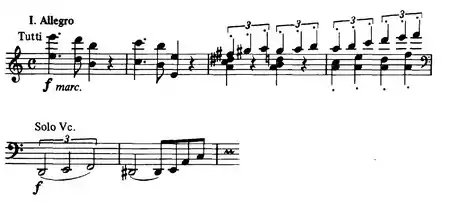双重协奏曲 (勃拉姆斯)
背景
这首双重协奏曲是勃拉姆斯为管弦乐队创作的最后一部作品。创作于1887年夏天,并于当年10月18日在德国科隆的居策尼希廳(Gürzenichsaal)首次演出[1]。据说,由于对于乐器不很了解,勃拉姆斯在写作时感到有些焦虑[2]。
这部作品是勃拉姆斯为大提琴演奏家羅伯特·豪斯曼[3] 和他的老朋友,小提琴家约瑟夫·约阿希姆而写的[註 1]。兩人亦是科隆首演的獨奏者。
协奏曲利用音乐主题A-E-F,这是F-A-E的一个排列,而F-A-E代表了约瑟夫约阿希姆的座右铭“自由但孤独”(Frei aber einsam)[6][註 2]。
分析
结构
和典型的协奏曲类似, 这部作品由快 - 慢 - 快三个乐章组成:快板(A 小调)、行板(D 大调),以及不太过分的快板(A 小调转A 大调)。
第一樂章

第二樂章

第三樂章

评论
约阿希姆和豪斯曼在1887-88年期间的音乐会上多次演奏了这首协奏曲,并由勃拉姆斯担任指挥。勃拉姆斯将手稿题赠给约阿希姆,上面的题字是“为他而做”。 不过克拉拉·舒曼对协奏曲却并不欣赏,认为这部作品“对乐器而言并不出色”[8]。理查德·斯佩奇特也批评这首协奏曲,将其描述为“勃拉姆斯最难以接受和没有欢乐的作品之一”。 据说勃拉姆斯曾经为小提琴和大提琴写过第二首协奏曲,但在受到负面的评价后销毁了他的作品。不过后来的评论家们对这部作品的评价甚好:唐纳德·托维曾经写道,协奏曲具有“巨大而彻底的幽默”。[9] 这部作品所面对的主要阻碍是它一直要求两位才华横溢而且同样出色的独奏家。
註釋
参考资料
- 參照
- . [2011-07-21]. (原始内容存档于2011-07-21).
- He disguised his reservations with joyless joking in his letter to Clara Schumann: "...I have had the amusing idea of writing a concerto for violin and cello. If it is at all successful it might give us some fun. You can well imagine the sort of pranks one might play in such a case," he wrote, adding "I ought to have handed on the idea to some who knows the violin better than I do." Litzmann, Schumann/Brahms Letters 8/1887, quoted by Jan Swafford, Johannes Brahms: a biography 1997:539.
- For Hausmann he had written the Second Cello Sonata the previous summer.
- "This concerto is a work of reconciliation— Joachim and Brahms have spoken to each other again for the first time in years", Clara Schumann noted in her journal after a rehearsal in Baden-Baden in September 1887.
- Schwartz, Boris. . The Musical Quarterly. Autumn 1983, LXIX (4): 503–526 [2008-03-16]. doi:10.1093/mq/LXIX.4.503. (原始内容存档于2006-10-03).
- Musgrave, Michael. . Music Analysis (Music Analysis, Vol. 2, No. 2). July 1983, 2 (2): 117–133. ISSN 0262-5245. JSTOR 854245. doi:10.2307/854245.
- Daniels, David. 3rd ed. Lanham: Scarecrow Press, Inc. 1996: 78. ISBN 0-8108-3228-3.
- Wollenberg, Susan. . Music & Letters. February 1993, 74 (1): 77–81. ISSN 0027-4224. JSTOR 735204. doi:10.1093/ml/74.1.77.
- Stein, George P. . Journal of Aesthetic Education (Journal of Aesthetic Education, Vol. 5, No. 4). October 1971, 5 (4): 99–113. ISSN 0021-8510. JSTOR 3331623. doi:10.2307/3331623.
This article is issued from Wikipedia. The text is licensed under Creative Commons - Attribution - Sharealike. Additional terms may apply for the media files.
